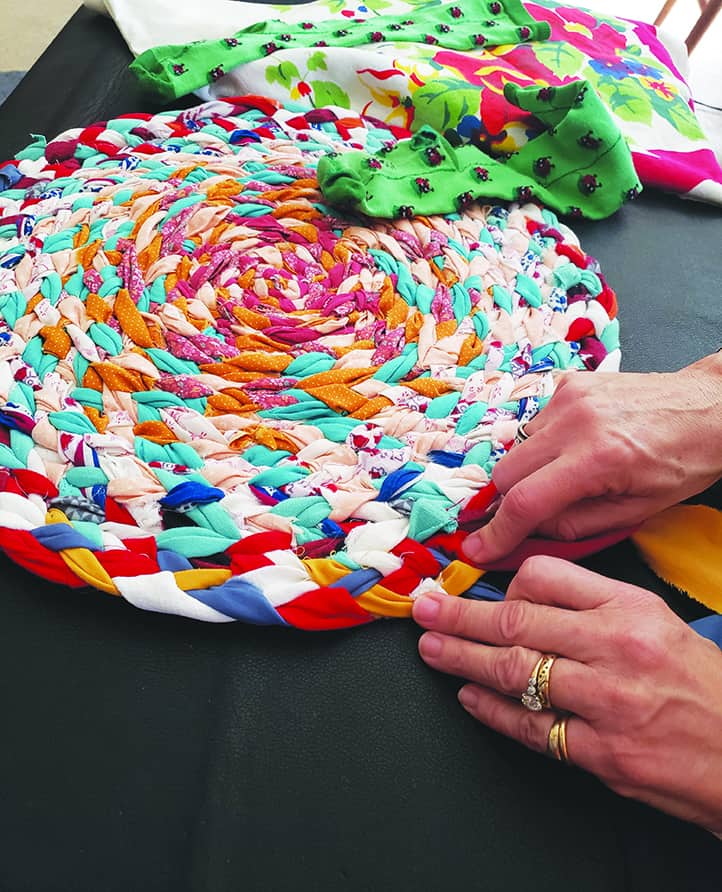
By Noreen McGill
Ever wonder what happened to that lost sock?
I might know.
My great uncle Ed’s farm in Chaplin, Connecticut, was our family farm. My mother’s great grandparents, Big Nannie and Grandpa, came from Ireland to farm and work in the Willimantic Textile Mills and for the railroad.
For me, the farm was freedom, fields, cows, apple trees, a barn with a hay loft to jump out of. Also a small farm house with a cold pantry, a wood fired kitchen stove, a living room with a massive fire place, a bee hive oven, an iron hook hanging from the ceiling and a magical room-sized round braided rug.
I would come into the cold pantry, take off my muddy shoes, put my hat and coats on the giant safe and head into the kitchen. I’d hang around and listen to my grandmother Nannie (Big Nannie’s daughter) and my Mom talk about stuff. Then I’d be off to the living room to collapse in the center of the rug, my fingers moving around and around the braided spiral.
It was mostly black but every so often it would have a red, gray, or blue strand. My Mom said Big Nannie made the rug by braiding together worn out old clothes, sheets and socks.
Socks!
I didn’t see any in the rug. How did she do that? Mom explained that Big Nannie would cut the socks around and around, like when you try to remove the skin of an orange and keep it all in one piece. That was all I needed. Soon I was braiding together some rags and one of my Dad’s black work socks.
This memory came to me when I was looking at page 18 of the “Winter/Spring 2020 ArtisTree/Purple Crayon Course Catalog,” which told of a “Braided Rag Rug Workshop.” I signed up. ArtisTree Community arts center, operates out of a renovated and repurposed barn and farmhouse in South Pomfret. The workshop, led by Caitlyn Eastman, began with a freshly laundered basket of old worn out clothes, a beautiful orange scarf with with birds on it, and sheets. We were encouraged to bring our own rags.
We came together, sharing our stories and the history of our fabrics. One of our group shared that her mother had died recently, and that she planned to make a rug using her mom’s favorite clothes. Another had moved recently from a big city on the West Coast to raise her children in our beautiful Vermont mountains. She wanted her little ones to have the freedom to play in open spaces. As she packed up her west coast home, she had sorted the worn linens and the old sheets and duvet covers from her children’s beds, and cut them into strips, which she rolled into colorful fabric balls. Caitlin’s peripatetic aunt came ready with tablecloths from her travels and a “hippie dress” that she had received as a gift from her siblings 40 years ago.
At first it was difficult for me to cut up these treasures. I urged my fellows to hold on to the table cloth, the hippie dress, the blouse, the scarf. Caitlin, who exudes energy and enthusiasm, encouraged us to be playful and fearless in our forays into (re)creation. I came to understand that I was about to engage in a process of transformation. To create the rug, I had to let go and rend what was.
When I tell people about this workshop, I hear their stories. Maureen remembers cutting up the work shirts her dad gave her for her school braided rug project. As Maurie gives me her mother’s vintage bold floral table cloth to braid into my rug, she recalls her friend who, after her two year stint in the Peace Corps in Hungary, cut up her clothes and made a braided rug. Bonnie’s bag of cast off clothes brings with it a reminder of the love she had for the braided rug her grandmother created from Bonnie’s old wool skirts as a wedding gift.
The process of creating the rug is cathartic, the tearing of fabric, liberating, the braiding, meditative and calming. The mantra “under, over, under, through,” is repeated as the strands of fabric swirl and form new patterns. My mind returns to the farm, Nannie and Mom, Big Nannie, the rug, the warmth, the fun, the freedom.
My rug will resonate with the past lives of Maurie’s mom’s festive table cloth, the ruffle from the hippie dress, Bonnie’s bag of bright colors, Caitlin’s raspberry blouse, my sister Tara’s bear flannel quilt fabric and both of my green ladybug socks. It will carry the story of passing quiet time while other activities are limited due to COVID-19 in this community where the generosity and love of neighbors is woven into my rug and into the fabric of my life.



